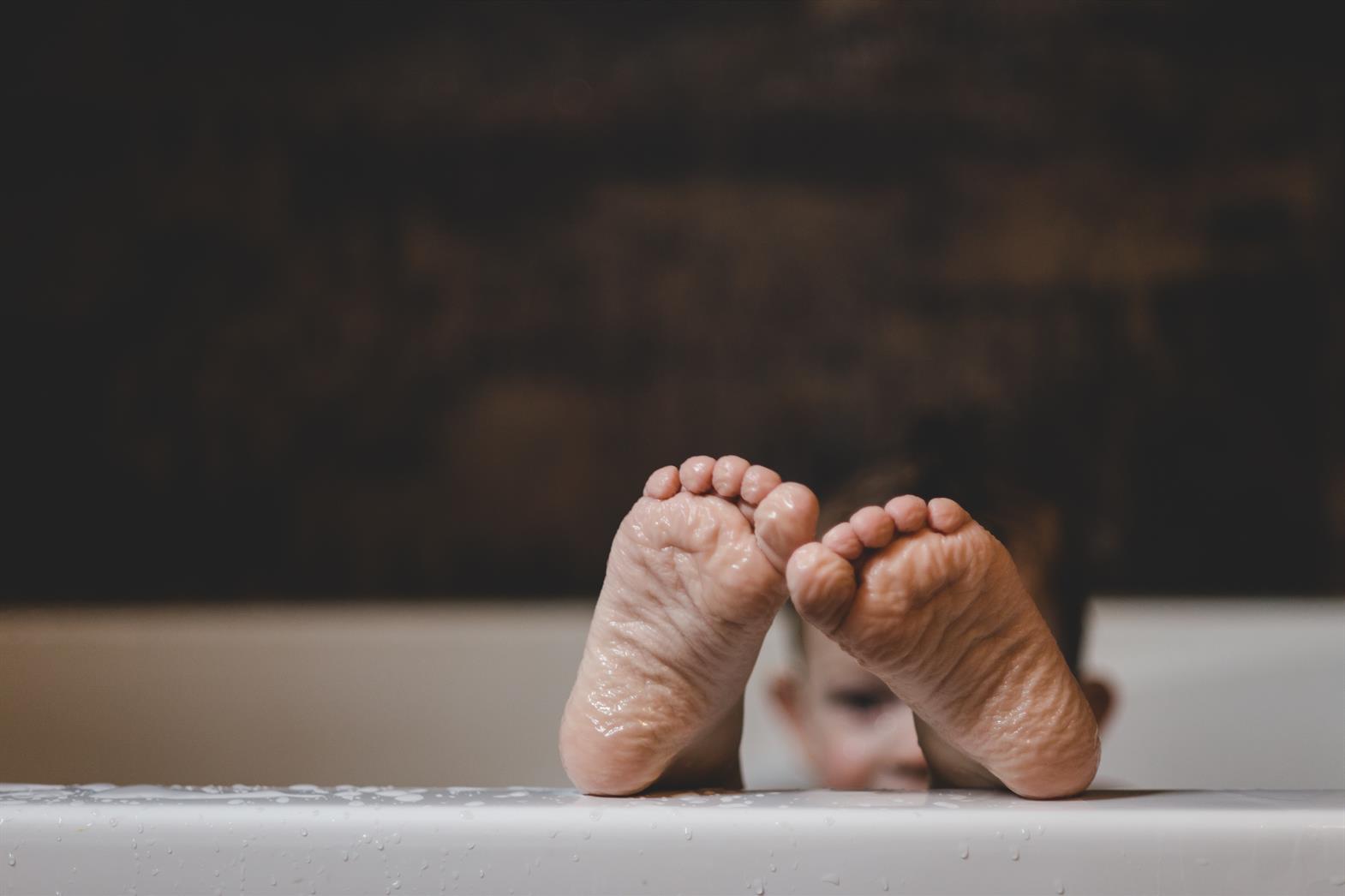*Please note that the following information should not take the place of a personal consultation, as appropriate, with an occupational therapist or a qualified health care professional.
Many children and youth on the autism spectrum experience challenges with self-care skills such as dressing, showering, toileting, toothbrushing and hair cutting due to many reasons including differences in social communication, autistic characteristics such as a preference for sameness, co-occurring intellectual disabilities, motor coordination difficulties, mental health conditions as well as the presence of significant sensory processing differences (Ben-Sasson et al., 2009, Gadow, Devincent, Pomeroy, & Azizian, 2005; Kanne, Abbacchi, & Constantino, 2009; Lecavalier, 2006).
Occupational therapists are health care professionals who are well trained in supporting children and youth on the autism spectrum to optimally engage and participate in self-care skills, or what occupational therapists refer to as activities of daily living (ADLs), while taking into consideration the person’s unique needs and skills. Occupational therapists’ expertise also lies in their ability to analyze and adapt the environment so that it can optimally support a person’s functioning. That is why recommendations involving ADLs are always a priority for occupational therapists as they are key in promoting and increasing a person’s independence both at home and in the community.
While there are many ADLs that we all engage in, this toolkit will specifically address the following five areas: hair cutting, toothbrushing, dressing and personal hygiene as these are the most commonly identified as challenging by parents (Reynolds & Lane, 2008).
Before we delve into these five different ADLs, it is important to keep the following over-arching principles in mind when thinking about how to best support your child or youth on the autism spectrum to engage and participate in self-care tasks.
Become a sensory detective!

Image by Ega Maulana from Pixabay
The world can be a very unpredictable place for children and youth on the autism spectrum and, as such, it is fundamental for caregivers to adopt a stance of curiosity when thinking about the behaviours that we see.
Keep in mind that it may be challenging for others (and for the child or teen themselves!) to figure out what may be contributing to behaviours and there are many factors that should be considered. For example, the child may not be able to automatically or effortlessly coordinate the small muscles of the hand to use a tool such as a toothbrush or washcloth or they may not be able plan the correct sequence of steps needed to complete a task. While there are many factors that may be interfering with the child’s ability to fully engage and participate in ADLs, one area that is often overlooked is the presence of sensory processing differences.
Sensory processing differences are well established in the research literature with up to 96% of children and youth on the autism spectrum demonstrating significant sensory processing challenges that interfere with daily tasks (Watling 2018). Behaviours associated with sensory processing differences include withdrawing from or avoiding certain types of touch (such as label tags in clothing, the feel of hair-clippers on the head, toothbrush in the mouth, seams in socks, shoes on the feet, etc.), covering ears in response to everyday sounds, and/or avoiding movement activities that are typically well tolerated by others. A limited food diet due to sensitivities to taste, texture or smell of foods is also common. Children and youth who experience sensory processing differences may also become easily overwhelmed in particular settings and may demonstrate strong emotional reactions or episodes of ‘sensory overwhelm’ to sensory input.
Add Predictability First!

Image by Megan Rexazin from Pixabay
Always consider environmental supports as they can be highly effective in supporting and enabling children and youth on the autism spectrum to engage and participate in self-care skills. There are many types of environmental supports such as:
Visual supports can be as simple as a sticky note with the message ‘brush teeth’ on the bathroom mirror or setting the toothbrush on the bathroom counter prior to the child or teen entering the bathroom. These simple visual strategies can be highly effective in reminding a person to initiate the steps necessary to complete a particular ask.
A visual schedule is a visual representation of the breakdown of steps that are embedded within one activity or a series of activities that will take place throughout the day. A visual schedule increases the child’s understanding of the task, clarifies the sequencing of the steps that need to be completed and also helps in decreasing anxiety by clearly describing what is going to happen and when.
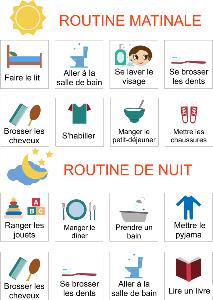
Another effective environmental support is the use of timers and pre-set cell-phone alarms to help cue the person to initiate a task. A visual timer for example gives a person a visual clue as to how much time is ideally left to complete a task.
Counting down or singing a song during a task can also be helpful as it gives the child an idea as to when the task begins ends (for example, singing the ‘itsy bitsy spider x 2 while combing the child’s hair). Listening to a particular song while showering could also be helpful for a teen on the autism spectrum as it can become an effective indicator as to how long a shower usually takes.
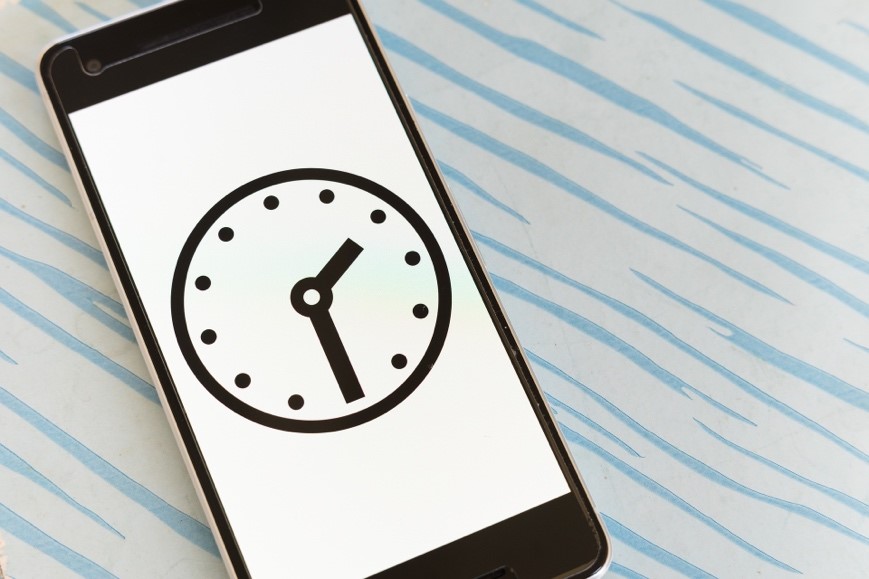
Image by Markus Winkler from Pixabay
The use of apps is also helpful as they can be motivating for the child or youth to complete the different steps embedded in a task. There are free apps for example that help a child by checking off the different steps involved in a task. This popular free toothbrushing app for example makes the toothbrushing task fun and assists the child in identifying exactly where they should be placing their toothbrush in their mouth.
The use of video modeling supports are also effective in enabling children and youth to engage and complete the steps involved in the ADL(Gardner & Wolfe, 2013; O’Handley & Allen, 2017 Cannella-Malone et al., 2011) Video strategies can include watching a video of someone else performing the ADL to reinforce how to complete a sequence of steps, producing and then watching a video of themselves performing the different steps of the ADL as well as having access to video prompting which involves using step by step video segments that are used by the child or youth as they are performing the ADL.
The use of a social story or social narrative to describe what is going to happen before, during and after the ADL is also recommended. A social story or narrative may also help the child to feel a greater sense of control which in turn decreases anxiety.
Lastly, establishing routines by helping a child or youth set up a schedule with specific times marked during the day or week when the ADL is expected to be performed can be helpful as it adds structure and predictability to each day. A child can decide which days of the week they will shower or take a bath on and which days they will wash their hair on for example.
Hair Cutting
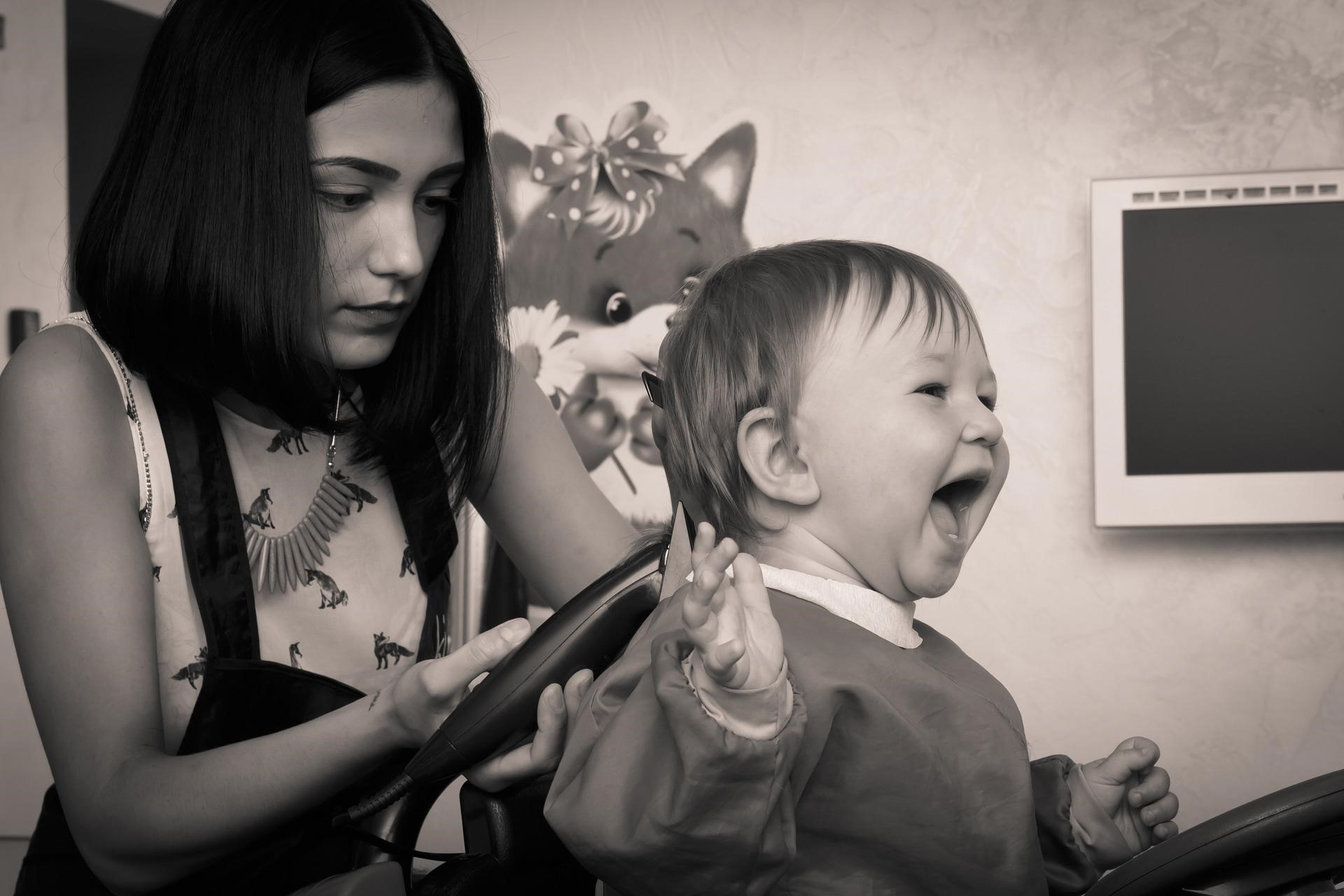
Image by нина лебедева from Pixabay
Prior to your child’s haircut:
- Speak with the hair stylist and see if it would be possible to visit the hair salon prior to the actual appointment so that the child can become familiar with all the sensory aspects of the room (the layout and size of the room, the type of chair they will be sitting on, the smells and sounds that are often found in a hair salon, etc.).
- Prepare the hair stylist by letting them know about your child or teen’s sensory processing differences such as sound sensitivities.
- Consider scheduling an appointment during a time when the hair salon is not as busy so there are fewer chances that the child will become overwhelmed by sensory input.
- Practice the steps involved in getting a haircut and review the visual schedule, social story or narrative of the steps required in getting a haircut with your child.
- Consider engaging your child in some calming deep breathing activities like blowing bubbles, playing a wind instrument like a harmonica, etc. to ensure that your child is as calm as possible prior to the hair appointment.
During the haircut:
- Encourage your child to take a preferred item to the appointment - a favourite toy, book or even a picture of a loved item (or pet!) left at home. These items can help motivate a child to complete the steps involved in the ADL of haircutting and they can also serve as powerful distractors away from focusing on the sensory elements of the environment.
- Use a mirror and verbal prompts to help your child predict when and where on their heads they are going to be touched.
- Experiment with noise-cancelling headphones or ear defenders to block out the noise of the clippers or hair dryers.
- Consider the sensory experience of feeling bits of hair falling on your child’s neck. Try blowing on your child’s neck or use a wet wash-cloth to remove hair bits throughout the haircut.
- Try a weighted toy or lap pad on child’s lap while seated in the chair.
- Other sensory strategies that could be helpful include providing calming sensory input by offering the child chewing gum or squeezing a fidget tool in their hands.
- Consider skipping the hair drying experience altogether due to potential sensitivities to noise.
Personal Hygiene

Image by SzaboJanos from Pixabay
Prior to personal hygiene tasks like hair washing or putting on deodorant:
- Show the shampoo, conditioner or deodorant to your child or teen and encourage exploration of these items by letting them smell and touch the bottles if needed.
- Consider using a shampoo and body wash combination product to eliminate an unnecessary second step.
- Try to determine the temperature of the water that your child prefers and have it set so that it remains the same throughout the hair washing experience. You might want to consider installing an automatic temperature valve to eliminate any chances that the water’s temperature will change suddenly.
- If your child is sensitive to smells, consider using non-perfumed soaps. Alternatively, if your child is a sensory-seeker (likes to touch, smell and chew on objects like tops of pens for example) then you might want to try products with strong but soothing smells like lavender, vanilla or strawberry.
- Some children are uncomfortable or not able to tolerate changing head positions such as tilting their heads back in the tub to have their hair washed. If this is the case, try a hand-held shower or offer a facecloth so that your child can cover their eyes while their hair is being rinsed. Another strategy would be to use a jug full of water to slowly rinse their hair off shampoo.
- Dim the lights and minimize sound if your child is easily overwhelmed by environmental sensory inputs.
- Try to give your child or teen choices such whether they will take a shower or bath.
- To increase general comfort with bathing for a young child, provide opportunities for water play with fun toys either at the sink or the bath.
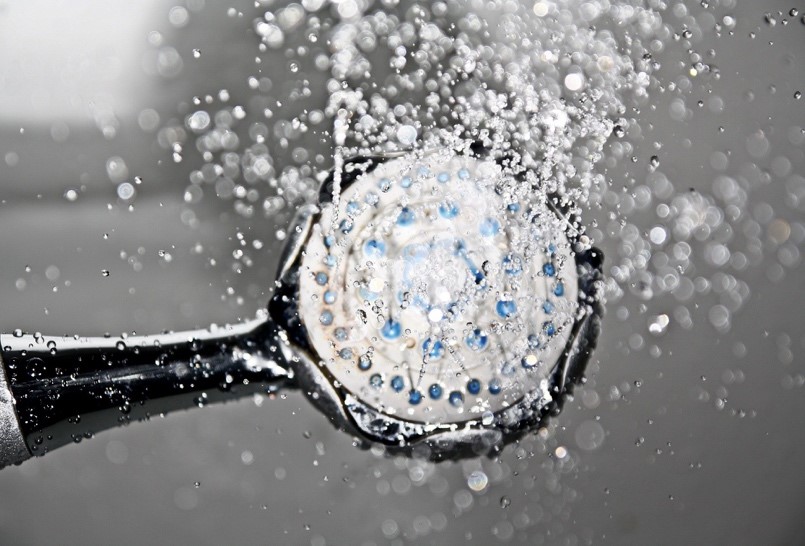
During hair washing:
- If you are washing the child’s hair during a bath, leave the hair washing to the end and try to make it as quick as possible. Add the fun factor by offering the child a special bath toy that likes to make its appearance during hair washing time only. This strategy alone can be a powerful motivator and can distract the child from over focusing on the sensory aspects of the experience.
- Consider skipping the hair drying experience. If this is not possible, make sure to show your child the blow dryer first and turn it on to a warm setting at the lowest speed. Let your child watch you blow some warm air on your own hands and then theirs so they can begin to predict that the experience will not hurt. Once your child is comfortable with the blow dryer, proceed with drying the hair.
- If your child is sensitive to having their hair combed, use a a wide tooth comb to create less tension in the child’s hair and make them more comfortable with the combing experience.
Toothbrushing:

Photo by Shalev Cohen on Unsplash
Prior to toothbrushing:
- Remember to explain clearly or through the use of a social narrative why it is important to brush teeth. You might want to go into a bit of the science and explain that we brush our teeth to prevent cavity pain (as well as minimize how many times one needs to see the dentist for example).
- Think of fun activities that involve teeth and toothbrushing to help your child become as familiar as possible with the task and begin to associate the toothbrushing with a fun activity. For example, consider jointly drawing a mouth with teeth in a large piece of paper and then having the child use a manual toothbrush to brush the ‘germs’ away.
- Leave the toothbrush on the counter to give your child a a visual prompt and reminder that they need to start the toothbrushing routine.
- Try purchasing toothpaste in a pump to promote independence.
- Consider experimenting with the toothbrushing tool to determine which one might best suit your child.For example, you can always start with using a baby toothbrush to begin to expose them to a toothbrush and gradually build up to a regular child sized one.
- Consider trying an electric, vibrating toothbrush for two reasons. These types of toothbrushes are easier to manipulate as they do not need as much fine motor control to place them on the teeth. An electric toothbrush also provides helpful sensory input that gives the child a stronger awareness as to where the toothbrush is in their mouth.
- A child might also softer or silicon toothbrush might also be easier for them to begin to accept the toothbrush into their mouth.
- If your child is overly sensitive to the feel of any toothbrush in their mouth, you may want to consider beginning with using a facecloth to wipe the teeth instead.
- Experiment with different flavoured toothpastes and see if you can find the mildest tasting toothpaste possible. Flavourless and foamless toothpaste may also help a sensory-sensitive child accept a toothbrush into their mouth.
- Alternatively, continue to experiment with child friendly flavours like mango, strawberry, and bubble gum. Try to avoid minty flavoured toothpaste as these are usually too strong in taste and not well tolerated by children with sensory processing differences.
- Once you find the ‘just right’ flavoured toothpaste, you might want to continue to purchase the same brand to facilitate the child’s recognition of the toothpaste and the ensuing toothbrushing activity.
- Consider having the child smell a preferred scent like say lavender prior to going into the bathroom to brush their teeth-smells have a direct effect on our emotions and may help in setting up the child for success!
- Singing a fun song on your way to the bathroom might also be motivating for the child.
- Adding some heavy work input such as playfully stomping towards the bathroom can be helpful as these types of activities calm the body down and enables a child to best engage in an ADL experience such as toothbrushing.
- Consider that your child’s sensory processing differences may extend beyond the mouth. They could be sensory sensitive to the bathroom environment in general such as the colours of the walls, the lighting, the smell of cleaning products, etc. It is important to create sensory friendly environments to set up your child or teen for success!
During toothbrushing:
- Show the child what they are expected to do by doing the activity yourself in front of the mirror. Try to break it down as much as possible into slow but actionable steps. Continue to praise and encourage your child every step of the way!
Dressing
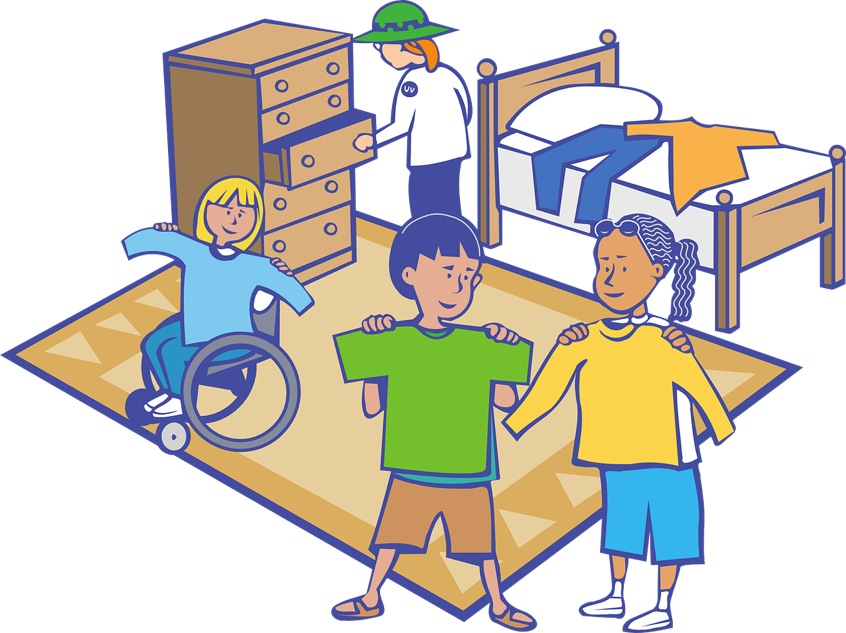
Image by Clker-Free-Vector-Images from Pixabay
Prior to:
- Encourage your child to engage in a quick, playful tug-of-war or ‘pushing the wall’ away with as much strength as possible. Activities that involve pushing, pulling, lifting or dragging are calming to our nervous systems and also help to increase the child or teen’s body awareness which is always helpful when it comes to supporting a child’s dressing skills!
- Consider sensory processing sensitivities to various fabric textures and purchase clothing that your child or teen feels comfortable in to increase the likelihood of dressing success.
- If your child experiences challenges with fine motor skills, consider adapting their clothing to increase independence and decrease frustration. Examples are attaching large zipper pulls to jackets, sewing on buttons with shearing elastic, elastic shoelaces of assorted colours and using coloured labels to indicate the front or back of a piece of clothing.
- Be aware of audio and visual sensory overload and minimize this during dressing
- Cut labels out of clothing or purchase clothing with labels already printed on the clothing.
- Wash clothes in unscented detergent and dry clothing in a dryer to ensure that the clothes remain soft.
- Provide the opportunity for your child or teen to choose their clothing for the day.
- Allow your child or teen to wear undergarments and socks inside out to prevent uncomfortable seams and tags.
- If well tolerated, offer to provide a deep pressure massage to your child’s arms and legs and see if providing this type of input is effective in decreasing tactile sensitivities
- Keep in mind that seasonal transitions may take a longer time: discuss it, prepare in advance and use social stories to explain this change.
During dressing:
Dress in front of a mirror to facilitate motor planning and anticipation of incoming tactile input as well as use
Try the backward chaining strategy which involves having your child complete the last step of the activity first, then the last two steps and so on.
- Begin the first step of a task and then have your child complete the last few steps if your child or teen is experiencing difficulties with initiating the sequence of steps of an ADL.
References:
Ben-Sasson, A., Hen, L., Fluss, R., Cermak, S. A., Engel-Yeger, B., & Gal, E. (2009). A meta-analysis of sensory modulation symptoms in individuals with autism spectrum disorders. Journal of autism and developmental disorders, 39(1), 1-11.
Cannella-Malone, H. I., Fleming, C., Chung, Y. C., Wheeler, G. M., Basbagill, A. R., & Singh, A. H. (2011). Teaching daily living skills to seven individuals with severe intellectual disabilities: A Canadian Journal of Occupational Therapy 87(2) Comparison of video prompting to video modeling. Journal of Positive Behavior Interventions, 13(3), 144–153. doi:10.1177/ 1098300710366593
Gadow, K. D., Devincent, C. J., Pomeroy, J., & Azizian, A. (2005). Comparison of DSM-IV symptoms in elementary school-age children with PDD versus clinic and community samples. Autism, 9(4), 392-415.
Gardner, S., & Wolfe, P. (2013). Use of video modeling and video prompting interventions for teaching daily living skills to individ- uals with autism spectrum disorders: A review. Research and Practice for Persons with Severe Disabilities, 38(2), 73–87. doi: 10.2511/027494813807714555
Kanne, S. M., Abbacchi, A. M., & Constantino, J. N. (2009). Multi-informant ratings of psychiatric symptom severity in children with autism spectrum disorders: The importance of environmental context. Journal of autism and developmental disorders, 39(6), 856-864.
Lecavalier, L. (2006). Behavioral and emotional problems in young people with pervasive developmental disorders: Relative prevalence, effects of subject characteristics, and empirical classification. Journal of autism and developmental disorders, 36(8), 1101-1114.
Marcotte, J., Grandisson, M., Piquemal, C., Boucher, A., Rheault, M. È., & Milot, É. (2020). Supporting Independence at Home of People with Autism Spectrum Disorder: Literature Review. Canadian Journal of Occupational Therapy, 87(2), 100-116.
O’Handley, R. D., & Allen, K. D. (2017). An evaluation of the pro- duction effects of video self-modeling. Research in Developmental Disabilities, 71, 35–41. doi:10.1016/j.ridd.2017.09.012
Reynolds, S., & Lane, S. J. (2008). Diagnostic validity of sensory over-responsivity: a review of the literature and case reports. Journal of autism and developmental disorders, 38(3), 516-529.
Watling, R., Miller Kuhaneck, H., Parham, L. D., & Schaaf, R. (2018). Occupational therapy practice guidelines for children and youth with challenges in sensory integration and sensory processing. AOTA Press.


